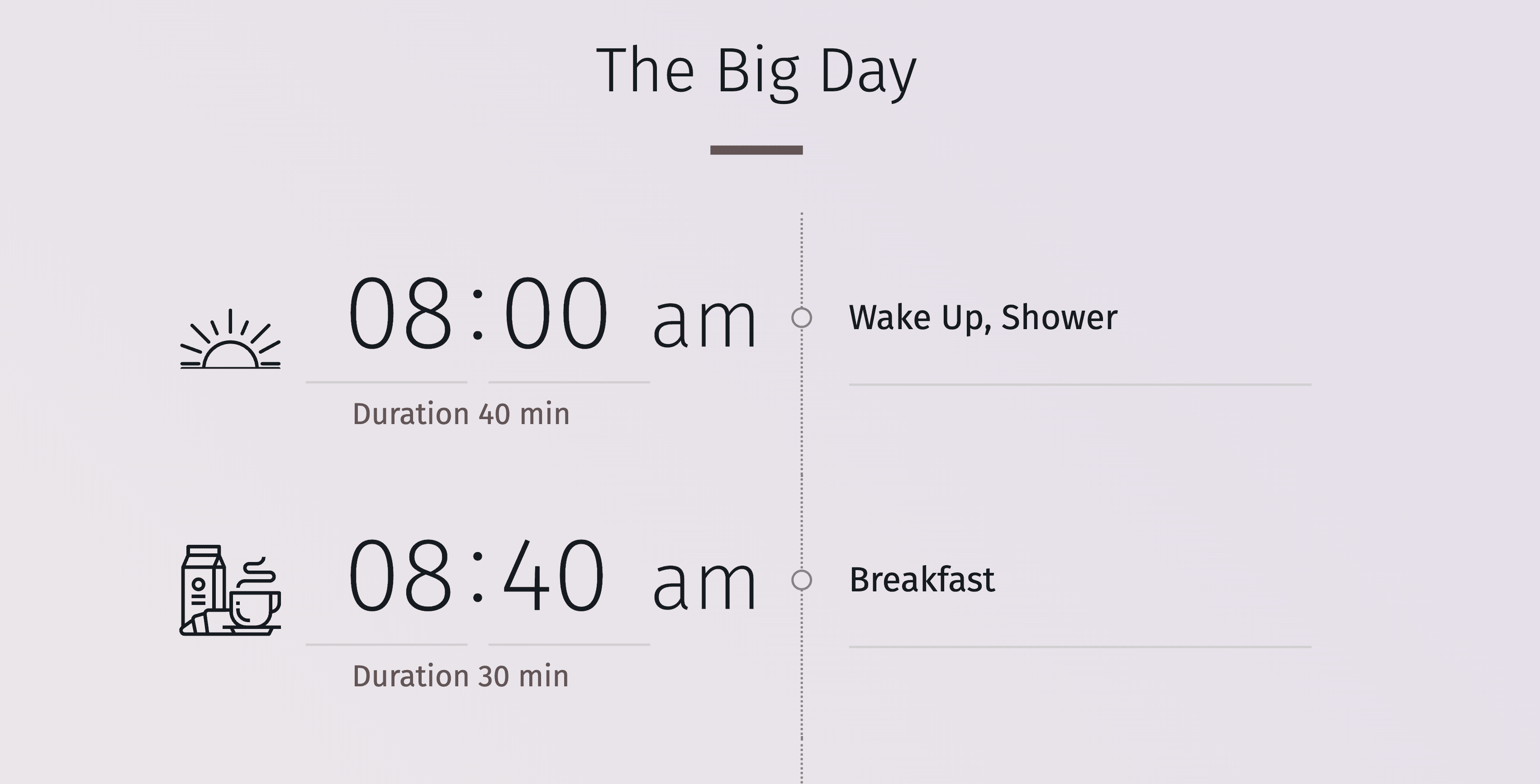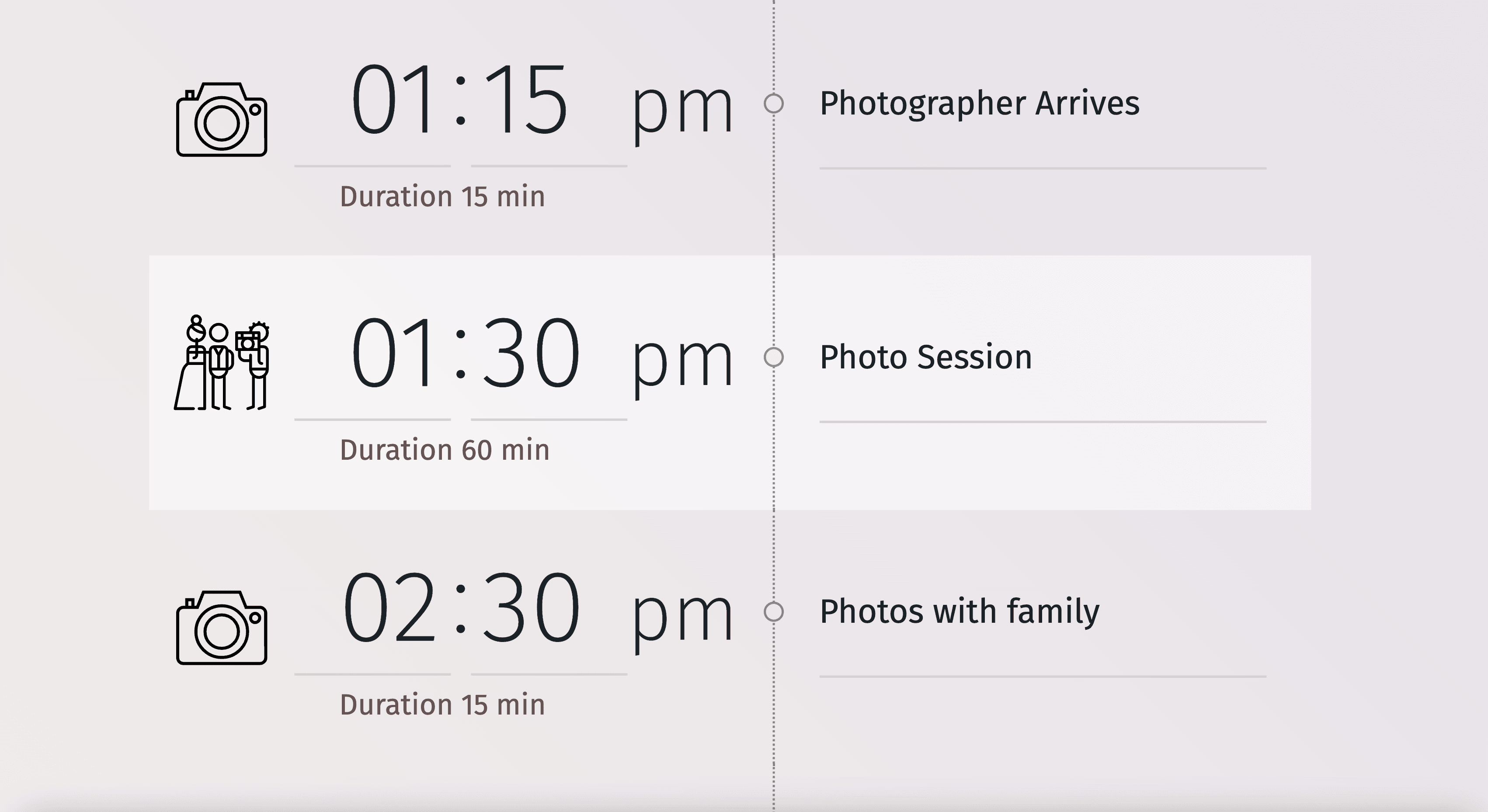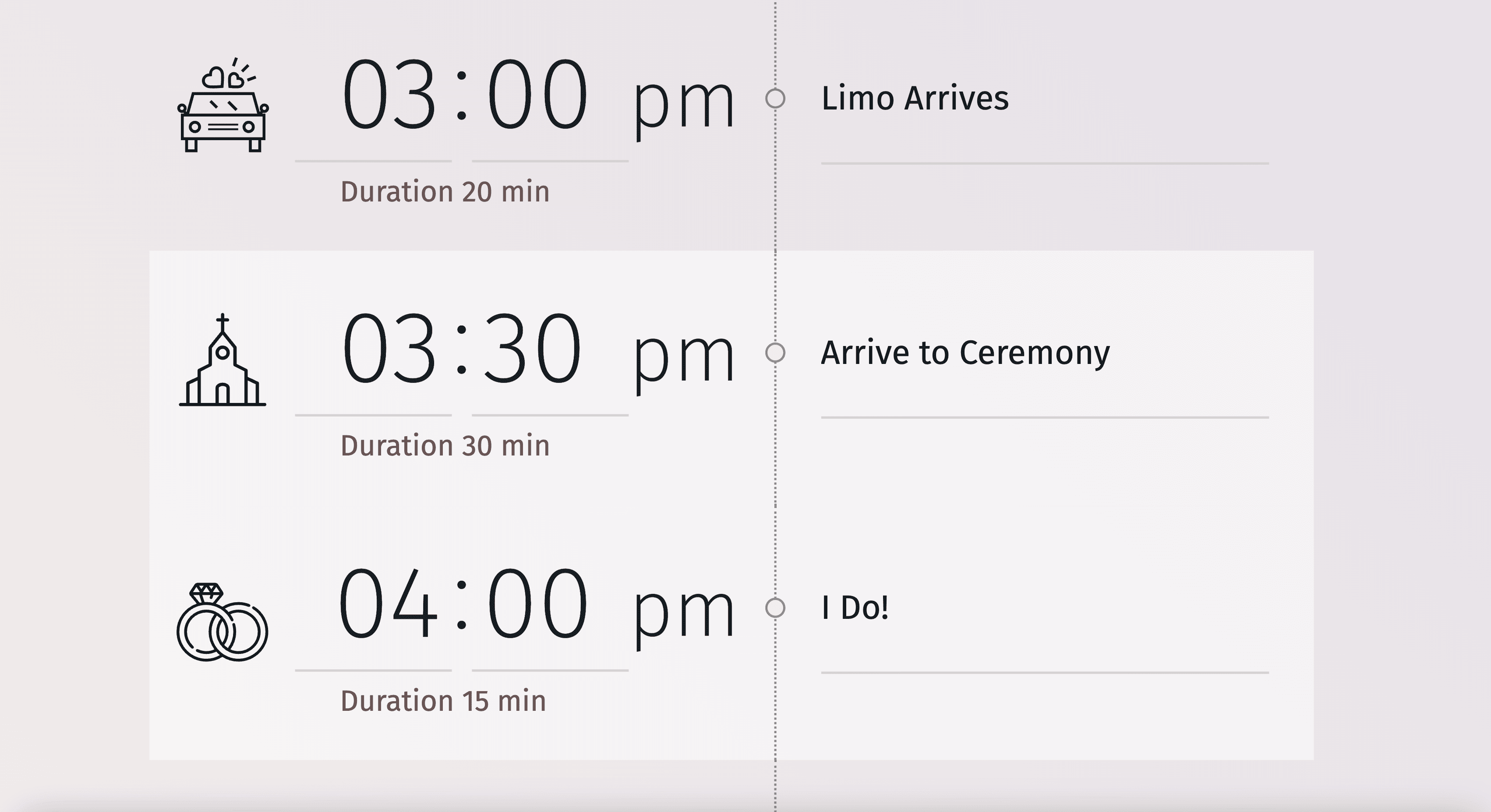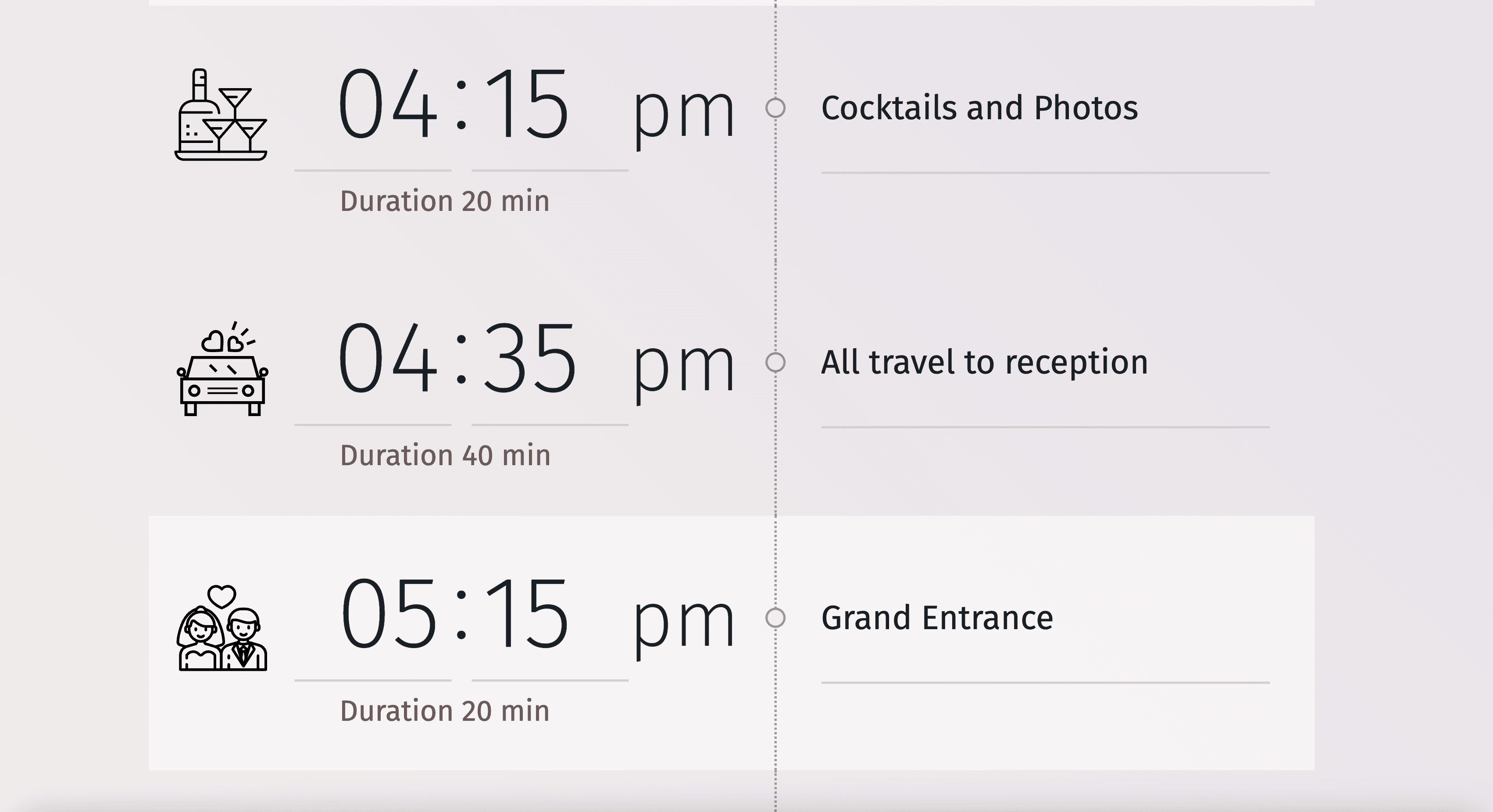Explore more wedding ideas & advice
Wedding Ceremony Timeline: How to Order Your I Do's
Our service has assisted tens of thousands of couples worldwide in planning their dream weddings!
We take away the guesswork around wedding ceremony outlines, and help you plan the perfect vows
A perfect, smooth-running wedding ceremony is like a magnificent ballet, or musical performance. It is a dance performed by the marrying couple, their officiant, and a selection of loved for the benefit of everyone involved. And like any dance performance, careful choreography is required to ensure everything runs smoothly. But, not every couple desires to have the same style of ceremony as the couple before them, and part of creating your own unique 'I Do's', is crafting a wedding ceremony timeline.
At the end of the day, unless you're marrying in a courthouse, or registry office, the actual order of wedding ceremony events can be moved around as you please. As can the people involved in your wedding vows. Some love the idea of friends and family taking part in almost every part of the ceremony, whereas others feel their wedding day should be all about them. Every wedding is different, and how you exchange your vows is up to you.
The best way to craft your wedding ceremony order of events, is to use a wedding itinerary template. An endlessly useful tool that'll help you keep track of not just the timeline of the wedding ceremony, but the entire day. Our itinerary builder is used by professional wedding planners, and marrying couples alike, who both appreciate the value of being able to precisely map out the perfect day. From wedding morning Prosecco, to end of the night getaway. Every moment can be planned, so not a moment is missed.
Start your wedding timeline
PLANNING . WEDDING — is easy to remember and even easier to use.
- A Guide to the Perfect Wedding Ceremony Timeline
- Seat Your Guests
- The Processional
- An Introduction
- Wedding Readings & Unity Ceremonies
- Vow Exchange
- The Exchange of Rings
- The Kiss
- A Few Final Words
- The Recessional
- Conclusion
A Guide to the Perfect Wedding Ceremony Timeline
As we mentioned, every wedding is different. Certain cultures, and religions, have their own wedding ceremony order. A Jewish wedding ceremony will feel very different from a traditional Hindu wedding, for example. But, there are certain aspects that remain the same in any kind of marriage ceremony. And today we're going to outline the basics. The key steps you need to plan, before adding in the elements that'll make your walk down the aisle feel unique.
Seat Your Guests
First order of business. Unless you're eloping on the beach at 6am, or out in the desert. It's assumed your ceremony will involve a wedding party, and a room full of guests. And this assorted group of loved ones need to be seated in preparation for your vows. Whether you have a detailed wedding ceremony seating chart or not, it's important to work out beforehand a rough idea of how you want guests to be seated. For a Christian wedding, for example, the families of the bride and groom are seated on the left and the right, respectively. Whereas the order is reversed for Jewish weddings.
Whether you choose to separate your partner's guests from your own, or mix everybody up, the ushers should start to seat guests 30 to 45 minutes before the ceremony. Which does sound like a long time to remain seated for, but trust us, a typical wedding guest will not stay seated for long. Not only will they find plenty of people to chat to on the way to their place, but they'll also happily jump up and mingle. Even when the family and wedding party should be seated. Give loved ones as much time as possible to find their seats, and make sure your ushers have the confidence to arrange them as you've requested.
Wedding ceremony guests are usually sat in order of closeness to the marrying couple. To make this VIP area clear, it's a good time to rope off, or decorate differently the seating for parents, close friends and family members. Just to ensure there can be no confusion.
Get started with your timeline
The Processional
Religious ceremonies have a strict processional order, with certain immediate family members needing to enter the room at different times. But if you're not holding a religious wedding, then the actual order, and people involved in the wedding procession should be considered fluid.
To help you get started with your wedding processional order, we've listed below the traditional, heterosexual order of wedding party members.
- Bride's mother
- Groom
- Best man
- Groomsmen
- Bridesmaids
- Maid of honor
- Flower girls & ring bearers
- Father of the bride & the bride walk down the aisle together
An Introduction
Once everyone has found their seat, the officiant or whoever is looking after the service will welcome the assembled guests, introduce themselves and then offer some musings on marriage. The content of their introduction can, of course, be decided by you, but it's also nice to have faith in the person you've chosen to lead your service. And let them be creative.
During the introduction, you should also expect the order of service to be explained, along with a few words behind the meaning of certain elements.
Wedding Readings & Unity Ceremonies
Wedding readings offer a delightful opportunity to share just how you feel about your partner, and your relationship. Whether you decide to recite a poem, book, film script or write your own words. A good ceremony reading rarely fails to leave a dry eye in the house. If you would like to bring an extra dynamic to this part of the ceremony, consider bringing in loved ones to speak on your behalf, or share their own thoughts.
Following, or during the readings, is also the time to perform unity ceremonies. Be it a unity candle, sand ceremony or hand fasting ritual. These symbolic, intimate ceremonies offer a wonderful opportunity to further strengthen your dedication to each other, and add further dynamism to this part of the wedding. If you'd rather separate the readings from the rituals, you could place them after the kiss within the wedding program.
Vow Exchange
Before the vows are exchanged, the officiant gives the couple a few wise words about their responsibilities to each other, while also reiterating the importance of their vows. The vows themselves are then typically read in turn. Very few couples manage to get through this stage of the ceremony without shedding at least a few tears. Therefore, it's wise, while wedding planning, to write your vows in advance, and practice them as much as possible. That way, when you reach the moment you have to deliver them for real, the words should come out more naturally, and you'll struggle less with the emotions.
If you'd rather your exchange of vows is a private affair, then it's perfectly acceptable to deliver them away from the public wedding ceremony setting.
The Exchange of Rings
Following the exchange of vows comes the rings. These wedding rings will either be held by the officiant, best man or designated ring bearer. Once handed over, the couple exchanges rings while the wedding officiant shares the significance of the moment.
Start your wedding timeline
The Kiss
The classic moment we've all been waiting for, the kiss! An always special part of the ceremony, and the official sealing of a marriage.
A Few Final Words
During traditional Christian weddings, prayers are usually shared before the end of the ceremony. But if you're not having this kind of wedding, your officiant will likely offer up a few closing remarks. A blessing of the union, and hope for their prosperous future.
The Recessional
The way your guests exit the ceremony is typically the reverse order of the processional. With the now married couple walking down the aisle cheered on by loved ones, followed by their immediate family, bridal party, and closest loved ones. The rest of the guests would then leave the space row by row.
There you have it, the wedding ceremony is complete! Of course, the actual wedding order of service on your big day may differ, but the elements we've listed will likely feature. Pick and choose the parts that work for you, and create your own wedding day timeline. Not just for the ceremony, but for cocktail hour and the reception. That way you can relax on the big day, knowing every event is planned to perfection.
Conclusion
In conclusion, the careful planning of your wedding ceremony timeline, particularly the crucial minutes before the ceremony begins, is essential in setting the tone for your special day. Understanding the traditional wedding ceremony structure and being able to adapt the wedding ceremony order to suit your personal style ensures a smooth and memorable experience for you and your guests. By meticulously organizing each segment of the ceremony, from the arrival of guests to the final recessional, you create a seamless flow that captures the essence of your love and commitment. This thoughtful preparation allows you to savor every moment without worry, making your wedding ceremony not just an event, but a cherished memory.
Explore other topics related to wedding timeline
The online Wedding Planning Assistant provides a wide range of professional tools, including a detailed wedding timeline, meticulously designed to aid you in the coordination and organization of your special celebration.



